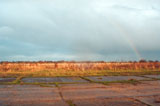 |
|
|
The construction of the aerodrome was begun in 1940 and it became fully operational on September 3rd, when the 25th operational Training Unit of Bomber Command moved from Cheddington. This then became an American flying base. Equipped withWellington bombers, Little Horwood was primarily a Training base although aircraft from here also took part in the first 1000 aircraft bombing raids on Germany and some Operational flying continued thoughout the rest of the war. The role of the base was a Training station, to familiarise the aircrew with flying a bomber under operational coditioners,both by day and night. The aerodrome ceased operational duties on January 15th, 1946 and the types of aircraft that had flown from Little Horwood included Wellingtons, Lysanders, Proctors, Ansons, Tiger Moths, Harvards, Masters, Warwicks, Martinets, Cygnets, Tomahawks, Oxfords and Hurricanes. The base was also used by aircraft ferring British prisoners of war back from Germany.
Little Horwood Signals Unit
Little Horwood was constructed for use as a satellite landing ground for the R.A.F.base at Wing , appointed for the use of the 26th, Operational Training Unit, prior to the construction of Little Horwood. In addition to training up to 1000airmen, Little Horwood also accommodated several hundred soldiers, stationed at the Manor, The locals were told that the camp was top secret. |
|



